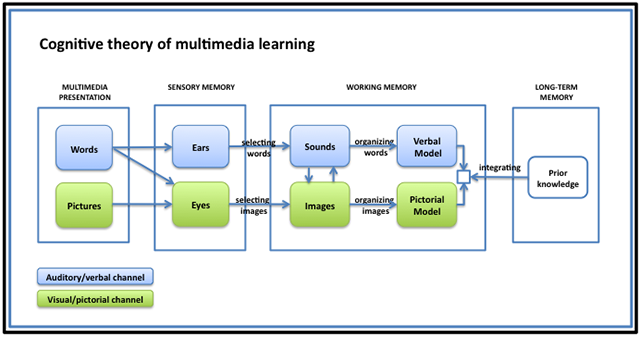Table of Contents
Cognitive Theory of Multimedia Learning
General
Cognitive theory of multimedia learning is one of the cognitivist learning theories introduced by an American psychology professor Richard Mayer in the 1990s. This theory is a sub-theory of John Sweller's cognitive load theory applied especially for multimedia learning, and therefore has many similarities with it. Basic assumption of Mayer's theory is that the human working memory has two sub-components that work in parallel (visual and verbal/acoustic) and that learning can be more successful if both of this channels are used for information processing at the same time.
What is cognitive theory of multimedia learning?
Mayer's theory is based on three assumptions suggested by cognitive research1)2):
- Dual-channel assumption - The verbal and visual channels (similar to what Baddeley called phonological loop system and visuospatial sketchpad3)) in our working memory are separated and can be used for processing information simultaneously thus enhancing process of learning. The suggestion that human working memory has more sub-components firstly came from the working memory models designed by Alan Baddeley and Graham Hitch in 19744) and reviewed by Baddeley in 19925). These findings where further incorporated to the Dual coding theory by Allan Paivio6) and later by Mayer and his colleagues.
- Limited capacity assumption - As Miller's Information processing theory has shown, these channels have limited capacity7) and limited time8) they can hold information. Too much information can therefore cause cognitive overload.9)
- Active-processing assumption - Learning is an active process of collecting, organizing and integrating new information10). Similarities with constructivist learning may be noticed in this definition.
Together with cognitive load theory, which offers a more detailed description of cognitive load types and possible causes of cognitive overload, the mentioned assumptions of cognitive theory of multimedia learning form a framework and theoretical basis for most contemporary research on learning. This research is mostly oriented on two goals:
- utilizing both information processing channels, and
- managing cognitive load and avoiding cognitive overload.
Research results have revealed a number of so called principles and effects describing different phenomena related to learning, instructional aids and ways of reducing cognitive load.
What is the practical meaning of cognitive theory of multimedia learning?
As mentioned, research in frames of cognitive theory of multimedia learning and cognitive load theory has revealed a number of principles and effects introduced by Sweller11), Mayer12), and a number of other researchers. Simplified, these principles and effects suggest that students learn better:
- from words and pictures than from words alone,
- from animation and narration together than only from animation or narration or on-screen text,
- when corresponding words and pictures are presented close rather than far from each other on the page or screen,
- when corresponding words and pictures are presented simultaneously rather than one after another,
- when extraneous interesting but irrelevant material is excluded rather than included,
- when important information in the learning material is marked or emphasized,
- when animation or text are broken down into smaller segments,
- when they are presented with worked examples before they try to solve a problem on their own,
- when they are prompted to self-explain a step in a procedure,
- when they study complex material in collaboration with other students,
- when their prior knowledge is activated prior to learning new material, and
- when they receive amount of guidance depending on their expertise level.
All of these design effects are stronger for low-knowledge learners than for high knowledge learners, and for high-spatial learners rather than for low-spatial learners.
Still, all of the mentioned suggestions for more efficient learning should be implemented with caution, since real-life learning environments are always much more complex than laboratory conditions. For more details and research status on every of the mentioned suggestions visit the principles and effects page.
Criticisms
Cognitive theory of multimedia learning is mostly subjected to same criticisms as the cognitive load theory since it is an extension of it.
Keywords and most important names
- Cognitive theory of multimedia learning, dual coding theory, visual and verbal/acoustic channel
Bibliography
Read more
Baddeley, Alan D. Is Working Memory Still Working? European Psychologist 7, no. 2: 85-97. July 2002.
